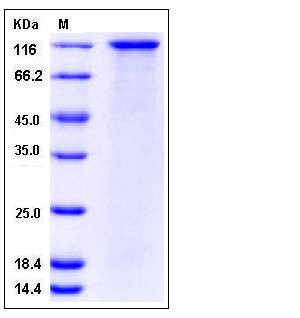Human SorCS1 Protein (His Tag)
hSorCS
- 100ug (NPP4286) Please inquiry
| Catalog Number | P11948-H08H |
|---|---|
| Organism Species | Human |
| Host | Human Cells |
| Synonyms | hSorCS |
| Molecular Weight | The recombinant human SORCS1 consists of 1000 amino acids and predictes a molecular mass of 113 kDa. In SDS-PAGE under reducing conditions, the apparent molecular mass of rhSORCS1 is approximately 130 kDa due to glycosylation |
| predicted N | Ser 111 |
| SDS-PAGE |  |
| Purity | > 92 % as determined by SDS-PAGE |
| Protein Construction | A DNA sequence encoding the human SORCS1 (Q8WY21-1) extracellular domain (Ser 111-Ser 1099) was fused with a polyhistidine tag at the C-terminus and a signal peptide at the N-terminus |
| Bio-activity | |
| Research Area | |
| Formulation | Lyophilized from sterile PBS, pH 7.4 1. Normally 5 % - 8 % trehalose, mannitol and 0.01% Tween80 are added as protectants before lyophilization. Specific concentrations are included in the hardcopy of COA. |
| Background | VPS10 domain-containing receptor SorCS1, also known as SORCS1 and SORCS, is a single-pass type I membrane protein which belongs to the SORCS family and SORCS1 subfamily. SORCS1 contains five BNR repeats and one PKD domain. SorCS1 is a member of the Vps10p-domain receptor family comprised of Sortilin, SorCS1, SorCS2, SorCS3, and SorLA. The common characteristic of these receptors is an N-terminal Vps10p domain, which either represents the only module of the luminal/extracellular moiety or is combined with additional domains. Family members play roles in protein transport and signal transduction. The individual receptors bind and internalize a variety of ligands, such as neuropeptides and trophic factors, and Sortilin and SorLA mediate trans-Golgi network-to-endosome sorting. Their prominent neuronal expression, several of the identified ligands, and results support the notion that members of this receptor family have important functions in neurogenesis, plasticity-related processes, and functional maintenance of the nervous system. Sortilin and SorLA mediate intracellular protein trafficking and sorting. SorCS1 binds platelet-derived growth factor-BB (PDGF-BB) and is expressed in isoforms differing only in their cytoplasmic domains. SorCS1 binds platelet-derived growth factor, a growth factor crucial for pericyte recruitment to the microvasculature, and may thus have a role in expanding or maintaining the islet vasculature. |
| Reference |
